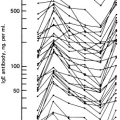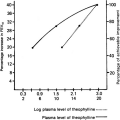Principles of Immunologic Management of Allergic Diseases Due to Extrinsic Antigens
Leslie C. Grammer
Kathleen E. Harris
Three principal modalities are available to treat allergic diseases: avoidance of allergens, pharmacologic intervention, and immunotherapy. Pharmacologic intervention is discussed in the chapters relating to specific allergic diseases and in the chapters devoted to specific pharmacologic drug classes. The immunologic interventions, avoidance of allergens, and administration of immunotherapy are the subjects of this chapter.
Allergen Exposure Risk
Sensitization to a variety of allergens has been associated with asthma among children and young adults in numerous studies, with odds ratios ranging from 3 to 19 (1). The particular associated allergen varies with geographic location. Sensitization to house dust mite as a risk factor for asthma has been reported in Georgia, Virginia, Australia, New Zealand, and the United Kingdom (2). In drier climates such as Sweden (3) and New Mexico (4), sensitization to cat and dog dander has been associated with increased risk for asthma. Children in the inner city who become sensitized to cockroach allergens are at increased risk for asthma (5). All of these studies suggest that avoidance of sensitization might reduce the predisposition to asthma. Unfortunately, avoidance is not always simple. For instance, even if cockroaches and pets can be avoided at home, school dust may have very high levels of these allergens (6,7), resulting in sensitization.
Avoidance of Antigens
Allergic diseases result from antigen–antibody interaction that subsequently results in release of mediators and cytokines that affect target organs. If exposure to the antigen or allergen can be avoided, no antigen–antibody interaction takes place, and, thus, there are no allergic disease manifestations. Consequently, the first tenet of allergic management is to remove the allergen if possible.
In the case of certain allergens, removal can be accomplished fairly well (8). For instance, an individual who is sensitive to cat or dog dander or other animal protein should not have the animal in the home if complete control of symptoms is the goal of management. Individualized, comprehensive, home-based environmental interventions to reduce exposure to indoor allergens have been reported to result in reduced asthma associated morbidity (9).
House Dust Mite
In the case of house dust mite allergy, complete avoidance is not possible in most climates, but the degree of exposure to this allergen can be diminished. House dust mite control measures that are evidence based are listed in Table 13.1.
Table 13.1 Control Measures to Reduce House Dust Mite Exposure | |||||||||
|---|---|---|---|---|---|---|---|---|---|
|
The effectiveness of controlling mite allergens in beds by using encasings is well established (10). Covers should be chosen that are sturdy and easily cleaned. Washing linens in hot water (>130°F) or tumble-drying at a temperature of more than 130°F for 10 minutes will essentially kill all mites (14,15). It is well recognized that carpet is a reservoir for mites; polished floors are preferable, especially in the bedroom. Several studies have reported the association between indoor humidity and dust mite allergen levels (10). For this reason, the relative humidity in the home should be kept below 50%.
Relative to ionizers or filtration devices, including HEPA filters, the data are conflicting. Although steam cleaning of carpets or use of acaricides can kill mites, the reduction tends to be incomplete and short lived. Freezing stuffed animals, blankets, or clothes will kill mites. However, washing is required to remove the allergen from these items. Vacuum cleaning does help
to reduce the overall allergen burden but is not likely to result in control of allergen from reservoirs like carpet and stuffed furniture (10).
to reduce the overall allergen burden but is not likely to result in control of allergen from reservoirs like carpet and stuffed furniture (10).
Mold Spores
Exposure to mold spores may also be reduced by environmental precautions (11). The patient should avoid entering barns, mowing grass, and raking leaves because high concentrations of mold spores may be found there. Indoor molds are particularly prominent in humid environments. Bathrooms, kitchens, and basements require adequate ventilation and frequent cleaning. If the patient’s home has a humidifier, it should be cleaned regularly so that mold does not have an opportunity to grow. Humidity should ideally be 25% to 50%. Water-damaged furnishings or structural elements should be completely replaced to avoid mold growth. Certain foods and beverages, such as aged cheese, canned tomatoes, and beer, may produce symptoms in some mold-sensitive patients. These foods and beverages should be avoided in highly sensitive subjects.
Cockroach Allergens
Control of cockroach allergen exposure may be very difficult, especially in the inner city. The National Co-operative Inner-City Asthma Study Group reported that intervention using abamectin applied by professional exterminators resulted in decreased Bla g 1 levels in the kitchen, only for a short time. Moreover, even the reduced levels were above those considered clinically significant (12). In another study of the effect of professional extermination using 0.05% abamectin and house-cleaning measures, there was also a decrease in the cockroach population in inner-city homes of Baltimore. However, at the end of the 8-month study, levels of Bla g 1 were still above the clinically significant level of 20 units per gram of house dust (13). In a study of cockroach extermination with hydramethylnon, there was persistence of elevated Bla g 1 and Bla g 2 6 months after treatment (14). Taken together, the results of these studies indicate that pesticides applied by professional pest control technicians are not effective. Sustained cockroach elimination in the inner city will therefore likely require regular extermination in all rooms, coupled with cleaning measures such as addressing reservoirs of allergen in carpets and furniture and keeping food sources such as leftovers, snacks, pet food, and garbage in tightly sealed containers.
Animal Dander
Compared with house dust mite and cockroach allergen, animal aeroallergens are associated with smaller particles that remain airborne for hours; thus, there is a rationale for using air filtration. However, the extent to which exposure to cat allergen can be effectively controlled by methods such as removing reservoirs like carpet and HEPA filtration is not clear. There are conflicting studies. Some studies have reported clinical efficacy using the combination of removal of reservoirs, keeping the cat or dog out of one room (preferably the bedroom), air filtration, and washing the pet (15,16).
Other Inhalant Allergens
Other airborne allergens, such as tree, grass, and ragweed pollens, cannot be avoided except by staying out of geographic areas where they pollinate. For most individuals, this is impractical socially and economically. Air-conditioning and air-filtration systems reduce but do not eliminate exposure to these pollens.
Immunotherapy
Immunotherapy is known by various other names: “allergy shots” to the lay public; hyposensitization or desensitization in older medical literature. These terms are not strictly correct in that they imply a mechanism that has not been proved. Desensitization applies to clinical situations in which antigens are administered in a few hours in sufficient quantity to neutralize available immunoglobulin E (IgE) antibody rapidly (17). This type of true desensitization may be necessary in treating patients with allergy to an antibiotic. It is not the operative mechanism in immunotherapy.
Immunotherapy, a term introduced by Norman and co-workers (18), does not imply a mechanism. It consists of injections of increasing amounts of allergen to which the patient has type I immediate hypersensitivity.
As a result of these injections, the patient is able to tolerate exposure to the allergen with fewer symptoms. The mechanism by which this improvement occurs has not been definitely established. However, over the years, several mechanisms have been postulated to account for the improvement. Immunotherapy was first used by Noon and Freeman, who observed that pollen was the etiologic agent of seasonal rhinitis and that immunization was effective in the treatment of various infectious diseases, including tetanus and diphtheria.
As a result of these injections, the patient is able to tolerate exposure to the allergen with fewer symptoms. The mechanism by which this improvement occurs has not been definitely established. However, over the years, several mechanisms have been postulated to account for the improvement. Immunotherapy was first used by Noon and Freeman, who observed that pollen was the etiologic agent of seasonal rhinitis and that immunization was effective in the treatment of various infectious diseases, including tetanus and diphtheria.
Immunotherapy was used empirically by physicians over the ensuing 40 years. Cooke (19) observed that cutaneous reactivity was not obliterated by allergy injections. Cooke also discovered a serum factor, which he called blocking antibody, in the serum of patients receiving immunotherapy (20). This serum factor could inhibit the passive transfer of allergic antibody described by Prausnitz and Küstner. However, there was not a constant relationship between blocking antibody titers and symptom relief.
The first controlled study of the efficacy of immunotherapy by Bruun was published in 1949 (21). Within a short time in vitro techniques were developed to assess objectively the immunologic results of immunotherapy. Many immunologic changes occur as a result of immunotherapy (22) (Table 13.2). Which changes are responsible for the efficacy of immunotherapy is unknown.
Table 13.2 Immunologic Changes with Immunotherapy | ||||||||
|---|---|---|---|---|---|---|---|---|
|
In general, immunotherapy is indicated for clinically significant disease when the usual methods of avoidance and medication are inadequate to control symptoms (23) (Table 13.3). It is considered to be effective in ameliorating symptoms of allergic rhinitis, allergic asthma, and Hymenoptera sensitivity. These topics are discussed in Chapters 9, 22, and 12, respectively. There are many examples of studies reporting the efficacy of immunotherapy in treating allergic rhinitis or allergic asthma caused by various inhalants, including ragweed, grass, and tree pollens, mold spores, and house dust mites (24) (Table 13.4). Assessment of efficacy in these studies is difficult because the diseases being treated are chronic and have variations based on geography, climate, and individuals. Assessments are generally made from subjective daily symptom and medication reports by the patient. In some studies, objective clinical evaluation by physicians or by nasal or bronchial challenge was also a part of the assessment. In several studies, children who received allergen immunotherapy developed fewer new sensitivities and less asthma than those who did not receive immunotherapy (25). Several meta-analyses of immunotherapy studies in asthma concluded that immunotherapy was efficacious, including a Cochrane Systematic Review in 2003 (24,26).
Table 13.3 Indications for Allergen Immunotherapy | |||||
|---|---|---|---|---|---|
|
Table 13.4 Examples of Double-Blind Placebo-Controlled Allergen Immunotherapy Studies Reporting Efficacy | ||||||||||||||||||||||||||||||||||||||||||||||||||||||||||||
|---|---|---|---|---|---|---|---|---|---|---|---|---|---|---|---|---|---|---|---|---|---|---|---|---|---|---|---|---|---|---|---|---|---|---|---|---|---|---|---|---|---|---|---|---|---|---|---|---|---|---|---|---|---|---|---|---|---|---|---|---|
|
There are limited studies that suggest allergen immunotherapy might be beneficial in patients with atopic dermatitis who also have aeroallergen hypersensitivity; there are also studies that report some benefit in oral allergy syndrome after allergen immunotherapy (27). At the present time, clinical studies do not support the use of allergen immunotherapy for food allergy, chronic urticaria, or angioedema (27).
Choice of Allergens
Stay updated, free articles. Join our Telegram channel

Full access? Get Clinical Tree








